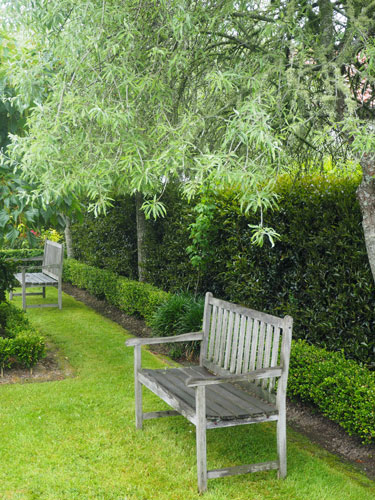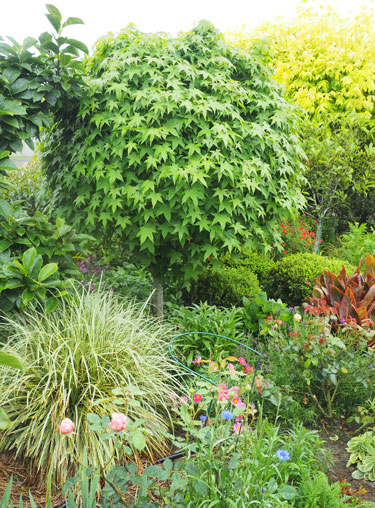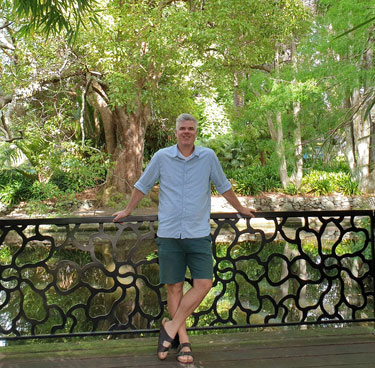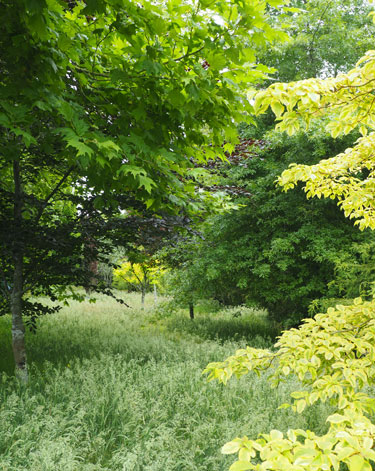Trees for urban spaces
When the air temperature cools but summer’s warmth is still held in the soil, nature’s premium planting season has arrived. Trees and shrubs planted in autumn and early winter establish new root growth that makes them well prepared for an explosion of top growth in spring.
For a hard-wearing garden that looks great all year round, a good rule of thumb is to plant at least half of it in evergreen trees, shrubs and ground covers. Long-lived, climate-tolerant trees and shrubs are key ingredients in a resilient garden with the best chance of making it through a flood or a drought.
Tree and shrub plantings also protect our environment when their deeply penetrating roots soak up excess water, helping to slow the flow of flood water and putting the brakes on excessive soil loss during a deluge.
Then, when the weather turns hot and dry and watering restrictions take force, those deeper reaching roots make the most of any moisture that lies deep down in the soil. Once established most trees can survive with only the water that falls from the sky.
As they mature, trees create microclimates for smaller garden treasures that need shade or shelter. In a warming climate, trees are playing an increasingly critical role in keeping people cool too. They also provide a habitat for birds, insects and essential soil organisms that help the soil - and the planet - healthy.
It is important to choose trees that thrive in your garden’s climate and soil, as well as serving their purpose. Deciduous trees, for example, offer summer shade while letting the sun through in winter. New Zealand native evergreens are among the toughest shelter screens.
When choosing trees for planting, big is not always better. The larger the tree, the harder it is for it to establish after planting and the more watering it will need. Often a smaller plant will outgrow a larger one planted at the same time. When planting hedges, look for healthy young trees of an even grade.
Water trees thoroughly before planting, then dig a planting hole at least twice the size of the tree roots. Remove the pot or planter bag and gently loosen the root ball. Plants that have outgrown their pots are often root bound and circling around the pot and matted at the base. Lightly shave the root ball to trim off any circling or matted roots. Water again thoroughly after planting to make sure the soil is snuggly around the roots. Apply mulch around the tree to help retain moisture and insulate the soil.
Trees for town-sized gardens
Feature trees
Acer (Japanese maple)
Backhousia citriodora (lemon myrtle)
Camelia
Cercis
Cornus (dogwood)
Cotinus (smoke bush)
Ginkgo fastigiata (column ginkgo)
Ginko Jade Butterfies (dwarf maidenhair)
Koelreuteria paniculata (golden rain tree)
Lagerstroemia (crepe myrtle)
Liquidamber ‘Gumball’
Magnolia
Malus (crabapple)
Prunus (flowering cherry)
Robinia pseudoacacia Lace lady
Ulmus ‘pendula' (elm)
Viburnum
Deciduous shade umbrellas
Acer (Japanese maple)
Albizzia julibrissin (silk tree)
Gleditsia Ruby Lace (purple honey locust)
Jacaranda
Malus floribunda (crabapple)
Robinia pseudoacacia 'Frisia'
Melia azedarach (indian bead tree)
Prunus (flowering cherry)
Trees for native birds
Abutilon (Chinese lantern)
Alectryon (titoki)
Aristotelia (makomako, wineberry)
Banksia
Callistemon (bottle brush)
Corokia
Leptospermum (manuka)
Sophora (kowhai)
Pittosporum
Metrosideros (pohutukawa)
URBAN FORESTS FOR GREENER FUTURES
The science is clear; trees cool the air. They do this both by shading and via transpiration, the natural process of releasing the water they ’ve absorbed from the earth back into the atmosphere, all the while taking in carbon and releasing oxygen. Trees are essential to our survival, not least in urban areas, where most people live.
But as towns and cities grow, the trees so vital to human wellbeing are at risk. There is an urgent need to slow down the loss of existing trees. Also, we need to protect the space needed for planting new trees.
Urban forest expert, Associate Professor Justin Morgenroth of The University of Canterbury says, “Studies have conclusively shown that trees cool local air and land surface temperatures, in some cases by tens of degrees! The importance of this can't be overstated in cities where temperatures are elevated by dark impervious surfaces, like pavements and buildings. Compounded with climate change, this so-called urban heat island effect will ensure our cities see much hotter summers ahead.”
To Justin, one of the biggest obstacles hindering tree planting in cities is a lack of early plantable space. “As cities develop and we cover soils with impervious pavements and buildings, land that’s most easily planted with trees disappears,” says Justin.
“To plant trees in highly developed environments requires greater management inputs and considerably deeper pockets. Some cities in Europe, Asia, and the US are undertaking de-paving to retrofit their cities with trees where grey infrastructure (like pavements) dominates. These cities recognise the immense benefits of trees but are having to pay a steep cost to plant them.”
All this feels somewhat overwhelming to a humble kiwi gardener, but how can we as individuals help? Justin urges us to talk to our local decision makers and politicians about the value of trees and why we should be prioritising them in our rapidly urbanising centres. “They need to hear that their constituents value liveable neighbourhoods with healthy urban forests,” he says.
“Trees are green infrastructure. Unlike grey infrastructure, they generally provide more benefits the older they get.”
Justin supports density in built environments but says this puts greater pressure on remaining common areas to provide green spaces for dense neighbourhoods. “Density done poorly leads to loss of green space, soil sealing, and extremely challenging conditions for any new tree plantings. I think it's critically important to maintain large connected communal areas for urban trees and green spaces.”
In the face of climate change, what kinds of trees should we be planting? Justin expects we ’ll see some changes. In our cities both natives and exotics are important given the huge variety of sites, environmental conditions, and planting objectives. “Native species have evolved to tolerate prolonged wet or dry conditions and there are plenty more exotics available throughout NZ ’s nurseries that can do the same,” he says.

29-Feb-2024

Silver pear, Pyrus salicifolia 'Pendula'

Liquidamber 'Gumball'

Magnolia 'Genie'

Justin Morgenroth


